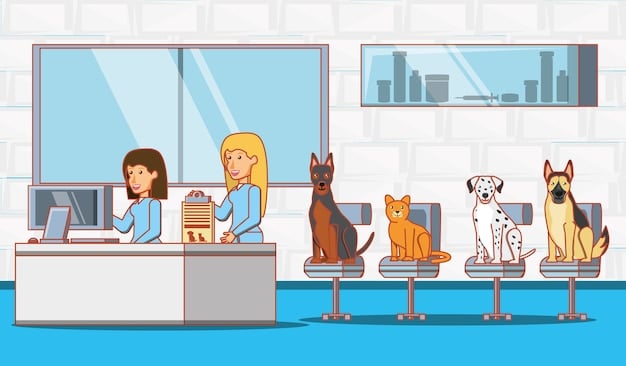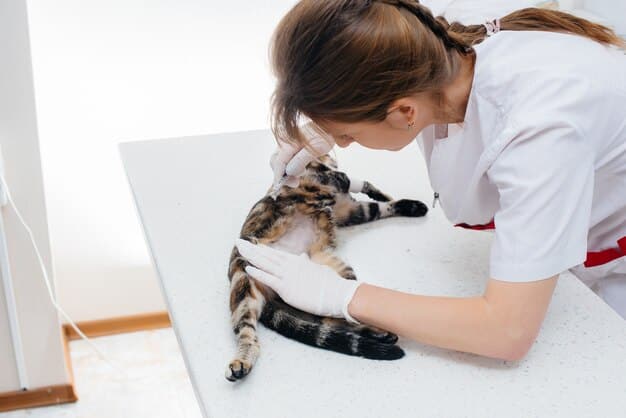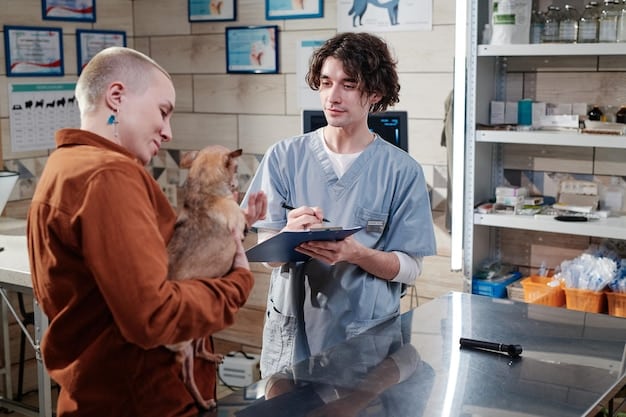Maximizing Rescue Impact: Partnering with Vets for Discounted Care

Maximizing Your Rescue’s Impact: Partnering with Local Veterinarians for Discounted Care involves creating mutually beneficial relationships where rescue organizations receive discounted veterinary services, enabling them to provide better care for animals and increase their adoption rates.
Maximizing Your Rescue’s Impact: Partnering with Local Veterinarians for Discounted Care is crucial for ensuring the well-being of rescued animals and optimizing resource allocation. By establishing strong relationships with local veterinary clinics, animal rescues can gain access to essential medical services at reduced costs, ultimately benefiting the animals in their care and the community they serve.
Why Partnering with Local Veterinarians Matters for Animal Rescues
Animal rescues often operate on limited budgets, making it challenging to provide comprehensive veterinary care to all the animals they shelter. By partnering with local veterinarians, rescues can significantly reduce their medical expenses while ensuring that animals receive the necessary treatments and preventative care.
These partnerships not only benefit the financial stability of the rescue but also improve the overall health and adoptability of the animals, increasing their chances of finding loving forever homes.
Reduced Veterinary Costs
One of the most significant advantages of partnering with local veterinarians is the potential for discounted services. Many veterinarians are willing to offer reduced rates to rescue organizations as a way to give back to the community and support animal welfare. These discounts can cover a wide range of services, including vaccinations, spay/neuter surgeries, dental care, and treatment for illnesses and injuries.
Improved Animal Health and Welfare
Regular veterinary care is essential for maintaining the health and well-being of rescued animals. Through partnerships with local veterinarians, rescues can ensure that animals receive timely vaccinations, parasite prevention, and treatment for any medical conditions they may have. This proactive approach to healthcare can prevent the spread of diseases within the rescue and improve the overall quality of life for the animals.

- Preventative Care: Routine check-ups, vaccinations, and parasite control help keep animals healthy and prevent common illnesses.
- Treatment for Injuries and Illnesses: Access to timely medical care ensures that sick or injured animals receive the treatment they need to recover quickly.
- Spay/Neuter Services: Affordable spay/neuter services help control the pet population and reduce the number of animals entering shelters.
- Dental Care: Regular dental cleanings and treatments can prevent dental diseases and improve overall health.
In conclusion, partnering with local veterinarians is essential for animal rescues for the financial benefits it brings, and for enhancing the health and welfare by providing comprehensive care for rescued animals, ultimately increasing their chances of adoption.
How to Find and Approach Local Veterinarians for Partnerships
Finding the right veterinary partner requires careful research and a strategic approach. Start by identifying veterinarians in your area who have a reputation for compassion and community involvement. Once you’ve identified potential partners, reach out to them to discuss the possibility of establishing a mutually beneficial relationship.
Effective communication and a clear understanding of each other’s needs are crucial for building a successful and lasting partnership.
Researching Local Veterinarians
Begin by compiling a list of veterinary clinics in your area. Online directories, local business listings, and recommendations from other animal welfare organizations can be valuable resources. Look for veterinarians who have a strong online presence, positive reviews, and a demonstrated commitment to animal welfare.
Preparing Your Pitch
Before reaching out to potential partners, prepare a clear and concise pitch that highlights the benefits of partnering with your rescue organization. Explain your mission, the number of animals you serve, and the types of veterinary services you need. Emphasize the mutual benefits of the partnership, such as increased visibility for the veterinarian and the opportunity to support a worthy cause.
- Highlight Your Mission: Clearly articulate your organization’s goals and the impact you make in the community.
- Quantify Your Needs: Provide specific information about the number of animals you serve and the types of veterinary services you require.
- Offer Mutual Benefits: Emphasize the advantages of the partnership for the veterinarian, such as increased exposure and community goodwill.
In short, approaching local veterinarians for a partnership is both strategic and well-planned to highlight the mutual benefits and needs of both parties, thus setting the stage for a successful, long-term collaborative relationship.
Building a Mutually Beneficial Partnership
The key to a successful veterinarian-rescue partnership is building a relationship based on mutual respect, understanding, and shared goals. Clear communication, well-defined expectations, and a willingness to collaborate are essential for creating a partnership that benefits both parties.
By fostering a strong and collaborative relationship, rescues and veterinarians can work together to provide the best possible care for animals in need.

Establishing Clear Expectations
Before formalizing the partnership, it’s important to establish clear expectations regarding the scope of services, pricing, payment terms, and communication protocols. A written agreement or memorandum of understanding can help ensure that both parties are on the same page and minimize misunderstandings.
Maintaining Open Communication
Regular communication is essential for maintaining a strong and effective partnership. Schedule regular meetings or check-in calls to discuss any issues, share updates, and explore opportunities for collaboration. Open and honest communication can help build trust and strengthen the relationship over time.
- Regular Meetings: Schedule regular meetings to discuss progress, address concerns, and plan for future needs.
- Transparent Communication: Be open and honest about your organization’s needs and challenges.
- Prompt Responses: Respond promptly to inquiries and requests from your veterinary partner.
To summarize, a successful partnership is built by communicating clearly, sharing the common ground, and defining roles and requirements as this leads to an environment of trust, mutual respect and excellent animal care.
Creative Ways to Enhance Veterinary Partnerships
Once a partnership is established, there are many creative ways to enhance its impact and strengthen the relationship. Consider offering volunteer opportunities for veterinary staff at your rescue, participating in joint fundraising events, or cross-promoting each other’s services on social media.
By exploring innovative ways to collaborate, rescues and veterinarians can create a more dynamic and mutually rewarding partnership.
Volunteer Opportunities for Veterinary Staff
Offering volunteer opportunities for veterinary staff at your rescue can be a great way to strengthen the partnership and provide valuable support to your organization. Veterinary technicians, assistants, and even veterinarians can volunteer their time to help with tasks such as animal handling, administering medications, and assisting with spay/neuter surgeries.
Joint Fundraising Events
Partnering with your local veterinarian on fundraising events can be a fun and effective way to raise money for your rescue and promote your partnership to the community. Consider organizing a joint event such as a pet wash, adoption day, or charity auction. These events can attract new supporters and generate valuable publicity for both organizations.
- Pet Washes: Offer discounted pet washes in exchange for donations to the rescue.
- Adoption Days: Host adoption events at the veterinary clinic to showcase adoptable animals and find them loving homes.
- Charity Auctions: Organize a charity auction with donated items and services to raise money for the rescue.
To conclude, there are several ways to boost veterinary partnerships that involve offering to volunteer for veterinary personnel, combining fundraising efforts, and promoting each other on social media to create a dynamic and mutually supportive community.
Overcoming Challenges in Veterinary Partnerships
While veterinary partnerships can be incredibly beneficial, they are not without their challenges. Common obstacles include communication breakdowns, differing priorities, and financial constraints. By anticipating these challenges and developing proactive solutions, rescues and veterinarians can navigate potential roadblocks and maintain a strong and productive partnership.
Addressing challenges openly and collaboratively is essential for ensuring the long-term success of the partnership.
Addressing Communication Breakdowns
Communication breakdowns can occur in any partnership, but they can be particularly detrimental in veterinary partnerships where the health and well-being of animals are at stake. To prevent communication issues, establish clear communication channels, set expectations for response times, and encourage open and honest dialogue.
Balancing Differing Priorities
Rescues and veterinarians may have different priorities, which can sometimes lead to conflicts. Rescues are primarily focused on saving and rehoming animals, while veterinarians are also concerned with running a successful business. To balance these differing priorities, it’s important to understand each other’s perspectives and find common ground.
- Understand Each Other’s Perspectives: Take the time to learn about each other’s goals, challenges, and priorities.
- Find Common Ground: Focus on shared values and goals, such as improving animal welfare and serving the community.
- Compromise When Necessary: Be willing to compromise and find solutions that work for both parties.
Overall, anticipating challenges and developing proactive solutions are essential for navigating potential impasses and maintaining a strong and productive partnership for long-term success.
Measuring the Impact of Veterinary Partnerships
To demonstrate the value of veterinary partnerships to donors, board members, and the community, it’s important to track and measure their impact. Key metrics to monitor include the number of animals served, the cost savings achieved, and the improvement in animal health outcomes.
By quantifying the benefits of the partnership, rescues can make a compelling case for continued support and investment.
Tracking Key Metrics
Start by identifying the key metrics you want to track, such as the number of animals receiving veterinary care, the average cost per animal, and the adoption rates for animals with veterinary care compared to those without. Use a spreadsheet or database to collect and analyze the data over time.
Demonstrating Cost Savings
One of the most tangible benefits of veterinary partnerships is the cost savings they can generate. Track the total amount of discounts received from your veterinary partner and compare it to the cost of providing the same services at full price. This data can be used to demonstrate the financial value of the partnership and justify continued investment.
- Number of Animals Served: Track the number of animals receiving veterinary care through the partnership.
- Cost Savings: Compare the cost of services with and without the partnership discount.
- Adoption Rates: Measure the adoption rates of animals receiving veterinary care.
To conclude, a focus on quantifying the benefits of veterinary partnerships demonstrates the value of partnerships and justifies continued investment.
| Key Point | Brief Description |
|---|---|
| 🤝 Building Partnerships | Focus on mutual benefits and clear communication. |
| 💰 Cost Reduction | Negotiate discounted care for improved financial stability. |
| 🐾 Improved Animal Welfare | Ensure regular and comprehensive veterinary care. |
| 📊 Impact Measurement | Track metrics to demonstrate partnership value. |
Frequently Asked Questions (FAQs)
▼
Partnering with a local veterinarian offers reduced costs for veterinary services, improved animal health, and a stronger community presence through joint events and fundraising.
▼
Animal rescues can approach local veterinarians by researching clinics with a community focus and preparing a pitch that highlights mutual benefits and specific needs of the rescue.
▼
Clear communication helps avoid misunderstandings, allows prioritization of animal care, fosters trust, and supports efficient management of resources and treatments in rescue operations.
▼
Challenges in veterinary partnerships include potential communication breakdowns, conflicting priorities between rescue operations and veterinary business needs, and managing financial constraints.
▼
Success in veterinary partnerships can be measured by tracking metrics like the number of animals served, cost savings achieved, and improvements in health outcomes. These metrics demonstrate value to stakeholders.
Conclusion
In conclusion, maximizing your rescue’s impact: partnering with local veterinarians for discounted care isn’t just a strategy, it’s a commitment to providing the best possible care for rescued animals. By creating strong, collaborative relationships with local veterinary clinics, animal rescues can enhance their financial stability, improve animal health outcomes, and increase their overall impact in the community.





